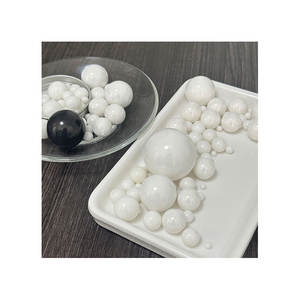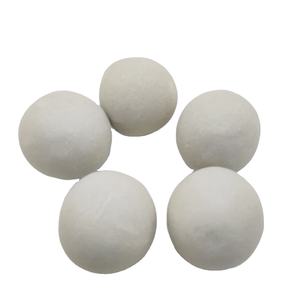1. Product Fundamentals and Microstructural Characteristics
1.1 Structure and Crystallographic Feature of Al ₂ O FOUR
(Alumina Ceramic Balls, Alumina Ceramic Balls)
Alumina ceramic spheres are spherical components fabricated from aluminum oxide (Al two O FOUR), a fully oxidized, polycrystalline ceramic that displays remarkable firmness, chemical inertness, and thermal stability.
The main crystalline stage in high-performance alumina spheres is α-alumina, which takes on a corundum-type hexagonal close-packed structure where aluminum ions inhabit two-thirds of the octahedral interstices within an oxygen anion latticework, providing high lattice energy and resistance to stage transformation.
Industrial-grade alumina spheres commonly have 85% to 99.9% Al Two O FOUR, with pureness directly influencing mechanical stamina, use resistance, and deterioration performance.
High-purity grades (≥ 95% Al ₂ O SIX) are sintered to near-theoretical thickness (> 99%) making use of sophisticated techniques such as pressureless sintering or hot isostatic pushing, reducing porosity and intergranular issues that might serve as stress and anxiety concentrators.
The resulting microstructure includes penalty, equiaxed grains uniformly distributed throughout the quantity, with grain dimensions typically ranging from 1 to 5 micrometers, optimized to stabilize toughness and firmness.
1.2 Mechanical and Physical Home Account
Alumina ceramic rounds are renowned for their extreme hardness– measured at around 1800– 2000 HV on the Vickers scale– exceeding most steels and measuring up to tungsten carbide, making them optimal for wear-intensive environments.
Their high compressive toughness (as much as 2500 MPa) makes sure dimensional stability under tons, while reduced elastic deformation boosts accuracy in rolling and grinding applications.
Regardless of their brittleness relative to steels, alumina balls display superb fracture sturdiness for ceramics, particularly when grain development is managed during sintering.
They keep architectural stability across a broad temperature level array, from cryogenic problems up to 1600 ° C in oxidizing atmospheres, far exceeding the thermal limits of polymer or steel counterparts.
In addition, their reduced thermal expansion coefficient (~ 8 × 10 ⁻⁶/ K) lessens thermal shock susceptibility, making it possible for usage in rapidly changing thermal atmospheres such as kilns and heat exchangers.
2. Production Processes and Quality Control
()
2.1 Forming and Sintering Methods
The production of alumina ceramic rounds starts with high-purity alumina powder, frequently stemmed from calcined bauxite or chemically precipitated hydrates, which is crushed to achieve submicron fragment dimension and narrow size circulation.
Powders are then formed into spherical green bodies making use of techniques such as extrusion-spheronization, spray drying, or round forming in turning frying pans, depending upon the wanted size and set range.
After forming, green spheres undergo a binder exhaustion phase followed by high-temperature sintering, usually between 1500 ° C and 1700 ° C, where diffusion devices drive densification and grain coarsening.
Precise control of sintering atmosphere (air or regulated oxygen partial pressure), heating price, and dwell time is important to accomplishing uniform shrinkage, spherical geometry, and minimal interior problems.
For ultra-high-performance applications, post-sintering therapies such as warm isostatic pushing (HIP) may be applied to eliminate recurring microporosity and better enhance mechanical integrity.
2.2 Accuracy Finishing and Metrological Verification
Following sintering, alumina rounds are ground and brightened using diamond-impregnated media to accomplish limited dimensional tolerances and surface area finishes equivalent to bearing-grade steel rounds.
Surface area roughness is normally decreased to much less than 0.05 μm Ra, reducing friction and use in vibrant call scenarios.
Critical high quality criteria include sphericity (discrepancy from best roundness), diameter variant, surface stability, and thickness uniformity, all of which are gauged using optical interferometry, coordinate determining equipments (CMM), and laser profilometry.
International requirements such as ISO 3290 and ANSI/ABMA specify resistance grades for ceramic spheres used in bearings, making sure interchangeability and performance uniformity throughout producers.
Non-destructive testing methods like ultrasonic examination or X-ray microtomography are utilized to discover inner splits, voids, or incorporations that can endanger lasting dependability.
3. Useful Advantages Over Metallic and Polymer Counterparts
3.1 Chemical and Rust Resistance in Harsh Environments
One of the most significant benefits of alumina ceramic rounds is their outstanding resistance to chemical assault.
They stay inert in the visibility of strong acids (other than hydrofluoric acid), antacid, organic solvents, and saline options, making them suitable for usage in chemical processing, pharmaceutical production, and marine applications where steel elements would certainly corrode swiftly.
This inertness protects against contamination of sensitive media, an essential factor in food handling, semiconductor manufacture, and biomedical equipment.
Unlike steel spheres, alumina does not generate rust or metallic ions, ensuring process purity and decreasing upkeep frequency.
Their non-magnetic nature even more extends applicability to MRI-compatible gadgets and electronic assembly lines where magnetic interference need to be avoided.
3.2 Put On Resistance and Long Life Span
In abrasive or high-cycle environments, alumina ceramic balls display wear prices orders of magnitude lower than steel or polymer choices.
This remarkable resilience equates into extended service periods, minimized downtime, and reduced total price of possession regardless of greater preliminary purchase costs.
They are widely utilized as grinding media in ball mills for pigment diffusion, mineral handling, and nanomaterial synthesis, where their inertness protects against contamination and their firmness makes sure effective bit size decrease.
In mechanical seals and valve components, alumina balls maintain limited resistances over millions of cycles, standing up to disintegration from particulate-laden fluids.
4. Industrial and Arising Applications
4.1 Bearings, Shutoffs, and Liquid Handling Equipments
Alumina ceramic balls are indispensable to hybrid ball bearings, where they are paired with steel or silicon nitride races to combine the low thickness and corrosion resistance of porcelains with the durability of metals.
Their reduced density (~ 3.9 g/cm SIX, about 40% lighter than steel) lowers centrifugal loading at high rotational rates, enabling much faster procedure with reduced heat generation and enhanced energy effectiveness.
Such bearings are utilized in high-speed spindles, oral handpieces, and aerospace systems where integrity under extreme problems is extremely important.
In fluid control applications, alumina balls serve as check valve aspects in pumps and metering devices, particularly for hostile chemicals, high-purity water, or ultra-high vacuum cleaner systems.
Their smooth surface area and dimensional security ensure repeatable securing efficiency and resistance to galling or confiscating.
4.2 Biomedical, Energy, and Advanced Technology Uses
Beyond conventional commercial duties, alumina ceramic balls are finding use in biomedical implants and diagnostic equipment as a result of their biocompatibility and radiolucency.
They are used in fabricated joints and oral prosthetics where wear debris need to be lessened to stop inflammatory responses.
In energy systems, they operate as inert tracers in storage tank characterization or as heat-stable components in concentrated solar energy and gas cell settings up.
Study is also checking out functionalized alumina balls for catalytic assistance, sensing unit aspects, and precision calibration criteria in width.
In summary, alumina ceramic spheres exhibit exactly how advanced ceramics connect the space between architectural toughness and practical accuracy.
Their distinct mix of solidity, chemical inertness, thermal stability, and dimensional accuracy makes them crucial popular design systems throughout varied sectors.
As making methods continue to enhance, their performance and application scope are expected to increase additionally into next-generation technologies.
5. Provider
Advanced Ceramics founded on October 17, 2012, is a high-tech enterprise committed to the research and development, production, processing, sales and technical services of ceramic relative materials such as Alumina Ceramic Balls. Our products includes but not limited to Boron Carbide Ceramic Products, Boron Nitride Ceramic Products, Silicon Carbide Ceramic Products, Silicon Nitride Ceramic Products, Zirconium Dioxide Ceramic Products, etc. If you are interested, please feel free to contact us.(nanotrun@yahoo.com)
Tags: alumina balls,alumina balls,alumina ceramic balls
All articles and pictures are from the Internet. If there are any copyright issues, please contact us in time to delete.
Inquiry us






